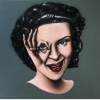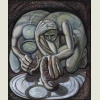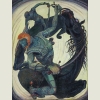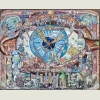|
In this series of articles about the Belarusian history of fine arts we are going to explore the position of Belarusian art on a global cultural level and the connection between Belarusian artists of the present and rich cultural heritage left by their predecessors in the 20th century.
1. 1900-1930s. Belarusian art in between two regimes: czarism and Stalinism. Belarusian land has given the world such names as Ferdynand Ruszczyc, Chaim Soutine, Marc Chagall, Vital Tsvirka, Nikolay Seleschuk and others. The number of original creative ideas and the best artworks of Belarusian painters of the 20th century have composed a bright picture of the development of fine arts in Belarus - the country that always treated any creative experiments and the positive impact of neighboring cultures with respect and tolerance.
But nevertheless, Belarus still remains a virtual space of pan-European significance with not enough explored and revealed traditions of fine art and cultural heritage as a whole. The question – what is the location of Belarus? – is the result both of national and European dramatic prehistory.
If you ask me, it is not a chronological order of facts that is of the most importance to the history of Belarusian art, but the attempts of fresh and depoliticized comprehension of the information that satisfies current social and cultural situation in the world.
Unfortunately, for a long period of time the development of Belarusian society hasn’t been based on its abundant history of fine arts. Even now young Belarusian artists know little about heritage of avant-garde experiments of 1920-30s and about the fate of unacknowledged artists who worked in the 1960-70s. At that time artists weren’t permitted to exhibit. A lot of names were excluded from books and university curricula because of Soviet regime’s policies.
Going back to the beginning of the 20th century we can observe that all the odds were in favor of Belarusian art and it started to participate in the European art experiments. To a greater or lesser extent they were realized in 1920s. Overall, the beginning of the last century was an important, erratic and contradictory period for art in Belarus. There was an intense competition between different creative philosophies. In spite of so-called “cultural program” of the Russian czarism (the main goal of which was to destroy any traces of Belarusian cultural authenticity) when the growth of the national arts was almost halted, Belarusian artists managed to follow the patterns of all-European aesthetic tendencies. And after 1905 the art life in Belarus resumed. A number of regional fine art centers like Vitebsk, Mogilev, Minsk and Grodno sprang up. Not to speak of Vilnia*, which remained Belarusian cultural capital and where some of the greatest writers and painters worked.
But not only visual art – the entire social and cultural atmosphere of that period was saturated with large-scale changes. This rebellious spirit infected young and talented artists who were searching for and who actually found new plastique, original figurative language, and who didn’t value obsolete traditions and trends much.
The distinct peculiarity of art life in Belarus in 1920s was that its Eastern regions grasped the ideas of Russian avant-garde and its Western part was still under the influence of secession and symbolism. The most plentiful results could be seen in constructivist architecture, painting, graphics and poster art. They all contributed to the foundation of Belarusian avant-garde in the 20th century. Actually, in 1920s painting “from nature” was taken as an anachronism against the dominant avant-garde background. Avant-garde consciously abandoned cultural memories of preceding epochs and was carried away with theosophical synthesis of different art schools and movements. It goes without saying that the 1920s was a period of formation of Belarusian contemporary fine art.
Alongside with such prominent avant-gardists as Kazimir Malevich, Marc Chagall and Wassily Kandinsky, there was a group of excellent portraitists – Yahuda Pen, Nikolay Tarasikov, Yakov Kruger, Petr Sergievich, Michail Stanuta -- and all of them worked in Belarus. It was an ongoing process of crystallization of the contemporary art in Belarus … but it never came finished. This search for forms and methods of reflection of Belarusian ethnic character lingered on. But everything created by Belarusian artists has become our genuine pride.
Sadly but the art development in Belarus continued only before late 1920s when the relative freedom of creativity existed. Huge achievements in art of that period weren’t recognized by the society. In 1930s the Soviet authorities suppressed any creativity and individualism in art. The artists who didn’t meet the dogmas of socialistic realism were labeled “enemies of the people” – they were banned from painting, exiled, jailed or murdered. But still Belarusian art survived… *after the Soviets gave up Vilnia in 1940 to Lithuanian SSR the town was renamed Vilnius
The next part of the article is coming soon.
Mikhail Barazna,
"Mastatstva" ("Art") magazine #6, 2004.
Adaption and translation from Belarusian by Bella Belarus, 2008 ©
|




